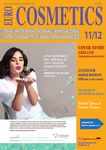Attaining Chinese Cosmetic Compliance with Changing EU Standards in the Post Brexit Era
←
→
Page content transcription
If your browser does not render page correctly, please read the page content below
REGULATION & LEGISLATION
China
Attaining Chinese Cosmetic Compliance with
Changing EU Standards in the Post Brexit Era
By Dr. Matteo Zanotti Russo *
Introduction two months by a change that, however, will be implemented. If
the validity of this law will still be kept (even if temporarly) in UK,
Regulatory aspects in the challenge of internationalization, or if it will be limited to continental Europe, and in this second
in a rapidly changing world. case what procedures will be implemented and required to con-
Never as in this period we witnessed a concertation of inter- tinue the sales and the passage of products across the UK border
national changes that influence, at the same time, the cosmetic with the EU.
panorama. Quarrels and reconciliation between economic super- In addition to the international instabilities, in my opinion we
powers (such as the US-China tariff war), conflicts and internal are witnessing an “acceleration” of regulatory developments, due
problems in a country (United Kingdom) that is experiencing the to additional concomitant factors. First of all, we see an evolution
turbulence of divorce from a Union of which it was one of the in the commercial and advertising channels, so that e-commerce
founders, a period of unknown regulatory scenarios, which will and e-marketing have reached fundamental importance. In the
be resolved within a few weeks, as in the case of Brexit. Perspec- digital field, we can say that we are in a “2” phase of the “web” era,
tive changes that heavily impact on regulations, therefore also on where consumers, businesses and professionals are reached
cosmetic rules: changes that overlap with the normal, previous mainly via mobile systems. We are in full “Social Era”, and the
and robust flow of regulatory and scientific updates that, even in development of these new channels has undoubtedly produced
quiet times, involves constant efforts by experts and companies. an expansion of the internationalization activities increasingly ex-
I do not think anyone could have imagined that the extension tended to smaller companies, compared to the past.
and validity of such an important and influential regulation such In Europe, the frequency with which binding opinions are ex-
as the European one could be uncertain and difficult to foresee pressed (opinions of the SCCS) 1 and the resulting technical ad-
justments have increased, while the time given to the companies
for adapting existing products to the new restrictions is becoming
shorter and shorter. Suffice it to say that the European Regulation
* Angel Consulting
University of Genoa – DISTAV is updated (albeit only in the technical annexes) several times per
Univesity of Rome Tor Vergata year.
1 /2–2019 2 EURO COSMETICSREGULATION & LEGISLATION
China
On the other hand, the commercial logics and the strategies of panies to change Regulatory Manager, if he/she is not perceived
development and expansion must necessarily take into account as a “problem solver” …).
the regulatory requirements, which, especially if they become Less noticeable is the distinction in China of cosmetics in two
complex and variables, can be experienced as a problem, and categories, which we also find in many other foreign regulations
exactly as limiting factors. The most open minded companies see (although the lists of the two categories do not normally coin-
the rules as opportunities to ride. As well as the most capable cide), as in Brazil, Russia and others: “special use” and “non-
entrepreneurs generally experience problems as opportunities special use” cosmetics.
and they consider changes positively.
Let’s examine the recent and imminent developments to under-
stand how to monitor, forecast (as far as possible) and manage Recent evolutions of the Chinese legislation:
the changes taking place. The goal is not to suffer changes. Be simplifications and future expectations.
ready for change, and at best to ride changes and grow thanks to
them. In recent months, some important changes have been made in
China, and other further changes have already been planned and
announced, and we can define the extent of developments as
Export to China. Conflicting emotions extremely substantial.
and practical problems. The new Chinese authorities that is put in charge by the
Chinese FDA was the China National Medical Products Adminis-
When I attend a meeting where I see a desperate Regulatory tration (NMPA), last March, 2018.
Manager and a joyful Export Manager at the same table, I have no First and most impressive: the concept of “Filing” was intro-
doubts: they intend to export to China. duced instead of the “Registration”, a great and significant step
The legislation in force in China for the registration and ap- towards the “Supervised Self-Monitoring” method adopted in
proval of cosmetic products is certainly among those that most Europe, even if limited to cosmetics classified as “non-special” use
stress the Regulatory Managers, in front of the enthusiasm of the (for them is kept the old procedure). At the end of the experimen-
Export managers, who (rightfully) see extremely interesting tation (December 2018), this modality has been extended to the
potential in the Chinese market. First of all the two regulations whole country, with the difference that in the 10 provinces in
(Chinese and European) are based on two diametrically opposite which the “filing” was initially tested, documentation is filed at
assumptions: the “pre-market approval” (China) and the “post- the local offices in charge, while in all other Chinese provinces
market survey” (Europe), from which the completely different are deposited directly at the NMPA. It is very important to note
procedures on many other aspects, with very few points in com- that the “filing” activities will be carried out by a Responsible
mon (until a few months ago) between the two regulations. The Person who will be responsible for the product, and not for the
same definition of cosmetics is not exactly referring to the same sole conduct of the registration, as in the past. The further chang-
products under the two laws: according to Chinese legislation, es announced by the Draft of the “Cosmetic Supervision and Ad-
cosmetic products can be applied only on the external surface of ministration Regulation” (CSAR) are further promising: The
the body, therefore products for oral hygiene and products in- change in the classification of some products, such as products
tended for intimate hygiene are excluded. At the same time, breast for the treatment of breasts that will be classified as drugs and the
beauty products in China are considered cosmetics, while other declassification of cosmetic deodorants “special use” a “non-spe-
products such as antiacne, whiteners or hairgrowt products are cial use”.
considered there to be cosmetic, which in Europe can only be In addition, the procedures for the introduction of new INCI
classified as cosmetics under certain conditions and are not ex- names will be simplified, and in the case of non-critical substanc-
empt from risks of disputes by the competent authorities. es the assignment can be made through a notification.
The differences of course are not limited to the classification, as These are certainly good news, because these changes make
the registration procedures (involving the approval of State offi- the procedure necessary to register products in China certainly
cially accredited laboratories) are among the most distressing of less complex, but beyond the practical aspects, clearly improved,
the international scenario, in addition to involving considerable it should be noted that the product and test requirements will not
costs and long times. The tests on animals are mandatory and the change. As well as other aspects that are strongly limiting today,
ingredients must be among those already officially translated and such as the obligation (which remains) to test products on ani-
included in the Chinese INCI list, otherwise the procedure re- mals.
quires about further several months of waiting and a considerable
investment, to then find the Chinese INCI name freely available
for everyone. The latter constitute further elements of discourage- Persistent incompatibilities: Animal Testing
ment and discontent for the Regulatory Managers of companies.
Bad feelings that become “bad news” about the products actually The real problem of animal testing is not given by legal limita-
exportable without making changes and about the timing for the tions: even if test on animals are not allowed in Europe, the ban
actual placing on the market, hence a contribution to the reputa- does not involve thirdy part in foreign countries, as in case of
tion not already very good of the Regulatory Managers, often Legal/Responsible Person in China that will manage the tests.
identified as “herald of bad news” (but in this case I suggest com- Then, the only limit for European companies is the impossibility
1/2–2019 3 EURO COSMETICSREGULATION & LEGISLATION
China
mal cruelty) will continue to not export to China. After all, it is a
more formal than substantial change, even though procedural
simplifications are always welcome.
Therefore, despite the content of the changes implemented and
being implemented in China, the most relevant aspects are: the
orientation of the changes, clearly addressed towards a “post-mar-
ket survey” approach and the very short time with which these
changes were implemented. This makes even optimistic about the
obstacles that have remained unsolved.
EU and Brexit
At the introduction of the Regulation 1223/2009 2 I was very
happy to realize the slides for my University courses and semi-
nars, in which I wrote about the “new European Regulation”. I
have always wondered when I should have removed the mention
“new” in the title, and a few days ago, when I was reviewing the
slides of one of my courses I thought that the term “new” is still
appropriate, despite five and a half years from the definitive im-
plementation dated July 2013. Personally I think that the Reg.
1223/2009 has not fully expressed its potential, and I believe that
many companies, many experts and some Competent Authorities
can still improve their familiarity with this regulatory tool that is
still innovative today.
Implementations and developments
Keeping the focus on the basic concepts expressed by Reg.
1223/2009, it is necessary to consider that some parts of it are still
being implemented. On some issues, such as packaging, the ef-
of using data coming from animals in the European Cosmetic fective implementation of the Regulation assumed in 2013 was
Product Safety Report (and therefore in the PIF). Problem easily the result of an excess of optimism or foresight. Precisely in rela-
solved as European companies and safety assessors have been tion to packaging, the main problem concerns a clear determina-
accustomed for many years to realize Safety Assessment without tion of the information that should be shared between the pack-
using animal tests: as we shall see in the next paragraph, one of aging supplier and the Safety Assessor (the European Task Force
the most important topics in Europe is given by the alternative is working on a guideline for future publication).
methods, the strategies that can replace data from animals and In addition to the structural and basic aspects of the Regulation
more specifically the most innovative and interesting are given by (which are still being refined and consolidated, and this is why I
the approach so called in silico (that involves the use of innova- still consider it “new”), the guidelines implemented by the Euro-
tive softwares for predicting potential risks derivated by the chim- pean Commission or the SCCS Committee are constantly being
ical structure of a substance), which is one of the tools provided implemented.
by the SCCS (the Scientific Committee for Consumer Safety) 1 to Among these, the guideline “The SCCS Notes of Guidance for
determine the toxicological effects of the ingredients. The real the Testing of Cosmetic Ingredients and Their Safety Evaluation,
problem inherent in the obligation to test on animals is given by 10th Revision” 1 (NoG), published in October 2018, is of consider-
the company “policies” and by the sensitivity of European able interest. Also in the previous Revisions, the SCCS NoG guide-
consumers, who are well informed on the subject, and many of line has always been a reference document, both for the relevance
them have spread the (founded) correlation between the distribu- of the source (the SCCS committee), and for the consistency of the
tion in China and he the compulsory animal tests that are re- contents, constituting, in fact, a basic guide for both the Safety
quested for that. Assessors both for the Competent Authorities.
After a more thorough verification of the changes underway in In the 10th review several important implementations were in-
the Chinese legislation, we realize that the companies that had troduced, among which the great importance assumed by in silico
the requirements to export to China will continue to do so. Those data and a new definition of Margin of Safety (MoS), for the cal-
who were limited or discouraged by the complexity of the proce- culation of which the concept of “Point” was introduced in this
dures will be slightly facilitated, but those who do not have the “revision of Departure”, which extends the MoS estimate also to
requisites to export to China (target of customers sensitive to ani- toxicological data without “threshold effect”. Without going into
1 /2–2019 4 EURO COSMETICSREGULATION & LEGISLATION
the details of the topic (which requires much more space even for disruption, whatever the outcome to its effective application of
a brief mention), suffice it to consider that the innovations ex- March 29th, “deal” or “no deal”: the effects are already manifesting
pressed in the 10th Rev. of the NoG will have a significant impact in the need to take action in the worst sense hypothesis, due to
on the Safety Assessment of new products and those already on the potentially very serious consequences deriving from having
the market. In fact, the Safety Assessment must be constantly up- underestimated the possibility of a break without agreement.
dated by law, and the consistent implementation of the NoG on Which is not unlikely. The European post-brexit era will see the
the subject undoubtedly requires a review of all the Safety Assess- birth of a new important extra-European country that will show
ments, after adjusting the assessment methods. It is therefore a differences from birth and will require specific operations. Then
great leap in level that will involve, and in a short time, an im- it will be clear if the British authorities will prefer to evolve their
mense work of revision, calculation assessment and reasoning of legislation towards a closer to the EU Regulation, which would
all the products currently on the market. Cyclopean and scientifi- undoubtedly facilitate both markets, or if they decide to maintain
cally far from simple work, as well as the implementation of toxi- their own strong identity by moving towards a norm away from
cological databases while they are already under improvements European requirements. To date it is impossible to know what the
given by in silico assessments and calculations, (this is certainly direction in which we will see the UK authorities move.
not an “informatic” exercise, but scientific, and high-level, act).
But despite the relevance (and extent) of these updates, I believe
that the greatest source of uncertainty and the most relevant and Conclusions: strategies for the new
striking change is undoubtedly given by the consequences of the EU-post Brexit/ UK / China scenarios
separation of the UK from the EU, planned for more than two
years but subject to a controversial resolution, which will materi- When an European company asks me how to deal with interna-
alize (in a still undetermined way) within a few months. tional markets, I recommend first of all implementing and opti-
mizing compliance with European standards, improving the “per-
formance” of the internal regulatory system, the documentations,
Brexit: Status and possible scenarios 3. the toxicological database, the implementation and control sys-
tem of the CPSR and the interface with the Safety Assessor and
What will be certain and definitive until March 29th? Probably: production management, internal or, a fortiori, external. In other
nothing. Understanding the possible strategies for the different words: implement your internal system, even before engaging in
possible scenarios that can be presented is therefore essential, the study of the requirements of new regulations or in the search
preventing the consequences of the more drastic (a no deal with for potential distributors. Improve efficiency and rationalize the
a hostile reciprocal attitude) of the possible scenarios, but effec- Regulatory Dept., at first.
tively and without excesses of defeatism. For example, the essential tool for European regulatory man-
The worst case scenario would be a “hard” Brexit. On March agement is the data base where all information concerning ingre-
29th, 2019, at midnight, Great Britain will no longer be a member dients and formulations is collected and updated. This tool,
of the European Union. And “no deal” in that case will mean sud- adopted (consciously or unknowingly) by all companies takes on
den mutual inapplicability of the regulations. In the case of the an even more important role when it is planned to enlarge the
cosmetic product, the most obvious consequence will be the non- markets abroad, as the database itself will be very useful to man-
recognition of the European Responsible Person in the UK. The age, from the R & D phases, the conformity of the products to the
common idea is that British authorities will produce a “photo- markets to which they will be destined, preventing the use of in-
copy” regulation of the European standard. Actually it could be gredients not allowed in the target country and allowing to pre-
logical to realize a UK law very similar to that made in the EU set the necessary documentation for foreign registrations.
with the contribution (at the time) of the British experts them- The rules: are limits or opportunities? Three important scenari-
selves, at least in a transition phase. Unfortunately, in reality there os were illustrated and commented, important in terms of size
are some aspects of European legislation that refer to important and subject to recent and important changes: China, European
external structures and commissions. Just think of the restrictions Union and, in the forthcoming scenario, United Kingdom as a
on CMR substances (Carcinogenic, Mutagenic and Reprotoxic), separate nation, due to the more pronounced and “clicked” word
for some of which the use in derogation is allowed only if a fa- in recent months: Brexit. But if we talk about norms and their
vorable opinion has been expressed by the SCCS, which is a com- development (hoping for their harmonization), exactly what are
mittee to which the UK will certainly not be able to refer. Among we talking about? Only limits? How can the limitations imposed
these substances we can cite one undoubtedly known: Ethanol. by growing international changing regulations help to grow the
Which is carcinogenic by ingestion but being admitted in food business rather than merely banish restrictions? The apparent
use and approved with specific opinion of the SCCS is admissible conflict between “regulatory” and “marketing”, where it seems
according to European law. It is not credible that on 29th March that the design of new cosmetic products arises from a bloody
alcoholic perfumery products are outlawed in the UK, but what- struggle between the marketing sector, which would have a claim
ever solution will be put in place by the British authorities this to superlative properties, and the regulatory sector, which seems
example gives us an idea of the size of the problem and of the paid with a “fee-per bad news”, how can it evolve into a market
complications not always easy to see at first sight. that pushes bigger and smaller companies to promote their prod-
In other words, Brexit already entails an important regulatory ucts in increasingly distant markets?
1/2–2019 5 EURO COSMETICSREGULATION & LEGISLATION
China
In fact, the most intelligent interpreters of cosmetic standards, Bibliography
in companies, have long understood that the regulations, created
to increase customer safety, are tools that go far beyond the sim- 1 SCCS/1602/18 - The SCCS Notes of Guidance for the Testing of Cosmetic In-
ple “obligation to comply”. The flow of scientific information and gredients and Their Safety Evaluation, 10th Revision
mandatory requirements, in addition to having to be respected 2 REGULATION (EC) No 1223/2009 OF THE EUROPEAN PARLIAMENT AND
OF THE COUNCIL of 30 November 2009 on cosmetic products (recast)
(and therefore their primary function consists in protecting the
consumer and the business itself, as a consequence), can also be 3 CTPA Brexit Factsheet, Olivia Santoni, 16 October 2018 Implications of ‘No
Deal’ Brexit. The Impact of a ‘No deal’ Brexit on the Cosmetics Industry n
an intelligent source of opportunities to overcome the strait mini-
mum law and to help the company distinguish itself and trans-
form the criticality into a perception of safety and therefore into
a true marketing tool. Those who have had the foresight to coor-
dinate the Regulatory Dept. (updated and internationalized) with
the R & D activities in their company has found that the Regula- Dr. Matteo Zanotti Russo
Owner and Fonder of Angel Consulting SAS,
tory aspects (and even more if they are oriented towards the glob- Cosmetologist Chemist
al market) have the possibility of giving a strong and unsuspected Professor of Cosmetology at University of
impulse to innovation. Siena, Rome-Tor Vergata, Genoa
Even today, therefore, openness and vision allow some compa- Member of European Responsible Person
Association - ERPA- Bruxelles
nies to emerge, even in local markets. International challenges
Speaker at international seminars and training
and stressful situations such as Brexit require further effort and courses on International Cosmetic Regulations,
further growth of companies in this direction. Because success on Safety Assessment, Claim Substantiation, GMP
international markets and survival at the “earthquake” of Brexit, Involved in training course organized by Cosmetica Italia Servizi on Safety
Assessment, GMP, Claim Substantiation
can be strongly helped by an elastic and rational mentality that
Partner of EU projects on development of new cosmetic technologies and
sees the regulatory aspects as basic and deserving of a futuristic new in silico tools under frame programs H2020 and Life (in past FP7)
and integrated organization. In the 2.0 world, it will be necessary, Expert-Partner of Cosmetic Associations and Chamber of Commerce in
in short, to adopt a regulatory management 2.0 as an element of Italy, Russia, Brasil, Taiwan, Israel
a general “forma mentis” 2.0. The new rules and changes for a Author of Chapter 2.2, Harry’s Cosmeticology:
An Overview of the Changing Regulatory Landscape in the U.S and the
curious paradox can not only protect the company, but can also E.U. and how to Deal with them
help to compete on international markets.
Stay up to date every month!
Do not miss any issue Print & Online
Subscribe now and order: abo@eurocosmetics.de
Contact:
INTER-EURO MEDIEN GMBH
P.O.B. 440255 · D-80751 München/Germany
Tel.: +49 (0) 89 - 36 03 74 27
For more information: www.eurocosmetics-magazine.comYou can also read


























































